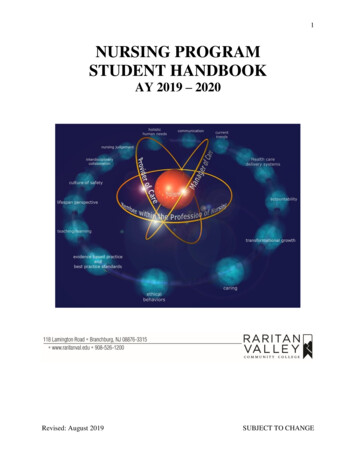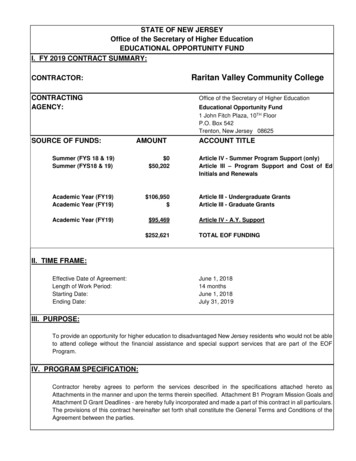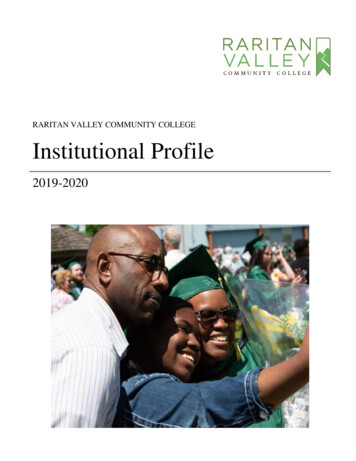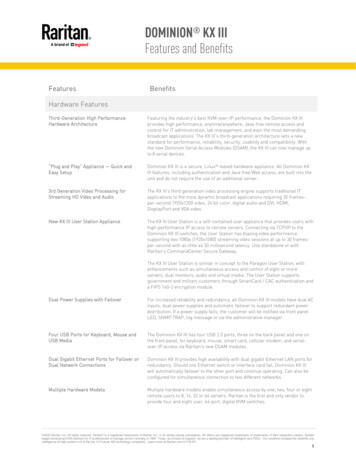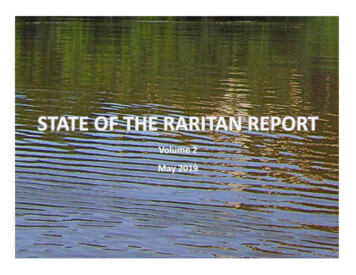
Transcription
STATE OF THE RARITAN REPORTVolume 2May 2019i
This page intentionally left blank.ii
State of the Raritan Report, Volume 2Sustainable Raritan River InitiativeRutgers, The State University of New JerseyNew Brunswick, New Jersey 08901http://raritan.rutgers.eduProduction TeamJulie BlumJohn BognarDr. Richard G. LathropSara J. MaloneElizabeth PyshnikDr. Jennifer WhytlawAbout the Sustainable Raritan River InitiativeRutgers University launched the Sustainable Raritan River Initiative (SRRI) in 2009 to convene scientists, engineers,business and community leaders, environmental advocates and governmental entities to craft an agenda for therestoration and preservation of New Jersey’s Raritan River, its tributaries and bay. A joint program of theEdward J. Bloustein School of Planning and Public Policy and the School of Environmental and Biological Sciences,the SRRI partners with other Rutgers units (through the Rutgers Raritan River Consortium) and with stakeholdersfrom across the Raritan region to ensure multidisciplinary and transdisciplinary perspectives and contributions.Participants share a commitment to science-informed policies for sustaining the ecological, economic andcommunity assets attributable to the Raritan.The SRRI fosters university-based research and scholarship that is focused on the Raritan. This knowledge is thentranslated into practical educational programming and technical assistance to support regional planning, policyand business decision-making. We conduct conferences and topical workshops, provide technical assistance, anddevelop anchor projects that raise the profile of the Raritan River.The SRRI and our watershed partners recognize the importance of a regional approach to resolving the complexissues associated with the restoration and future protection of the Raritan River, its estuary and all its tributaries.CitationMalone, S.J., R.G. Lathrop, E. Pyshnik, J. Blum, J. Whytlaw, and J. Bognar. 2019. State of the Raritan Report,Volume 2. Sustainable Raritan River Initiative, Rutgers, The State University of New Jersey, New Brunswick, NJ.Image 1. Albany Street Bridge by Mario Burgeri
AcknowledgementsWe would like to acknowledge the following individuals and their organizations for contributinginformation to the State of the Raritan Report, Volume 1 and for providing suggestions on thecontent for this Volume 2.Michael Catania—Duke Farms FoundationChad Cherefko—United State Department of Agriculture, Natural Resources Conservation ServiceEllen Creveling—The Nature ConservancyHeather Fenyk—Lower Raritan Watershed PartnershipCarrie Ferraro—Department of Marine & Coastal Sciences, Rutgers School of Environmental & Biological SciencesAlan Godber—Lawrence Brook Watershed PartnershipKathy Hale—Watershed Protection Program, New Jersey Water Supply AuthorityChristine Hall—United State Department of Agriculture, Natural Resources Conservation ServiceKen Klipstein—Watershed Protection Program, New Jersey Water Supply AuthorityGabriel Mahon and staff—New Jersey Department of Environmental Protection, Division of Water QualityDebbie Mans—(formerly with the) NY/NJ BaykeeperKristi MacDonald—Raritan HeadwatersRobert Pirani—NY-NJ Harbor & Estuary ProgramDavid Robinson—Department of Geography, Rutgers School of Arts and SciencesBill Schultz—Raritan RiverkeeperIsabelle Stinnette—NY-NJ Harbor & Estuary ProgramSteve Tuorto—The Watershed Institute (formerly Stony Brook & Millstone River Watershed Association)Special thanks toDean Piyushimita (Vonu) Thakuriah, Rutgers Edward J. Bloustein School of Planning and Public Policy, andExecutive Dean Robert Goodman, Rutgers School of Environmental & Biological Sciences for support of theSustainable Raritan River InitiativeChancellor Christopher Molloy, Rutgers University—New Brunswick for support of the Rutgers Raritan RiverConsortiumGretchen and James Johnson for support of the Johnson Family Chair in Water Resources and Watershed EcologyImage 2. Untitled view of a good trout fishing spot by Judy Shawii
Executive SummaryThis document continues efforts to update keyindicators of water quality and watershedhealth for the Raritan River Basin. The health ofthe Raritan Basin was originally assessed in the2002 Raritan Basin: Portrait of a Watershed asdeveloped by the New Jersey Water SupplyAuthority and updated in the SustainableRaritan River Initiative’s 2016 State of theRaritan Report, Volume 1. The objective ofthose reports, and this one, is to informwatershed management planning and watersupply and natural resource protection needs inthe Raritan Basin.This State of the Raritan Report, Volume 2evaluates eight broad areas encompassingthirteen key indicators that could eitherimpact water quality or watershed health orthat influence quality of life in the basin. Theeight areas and thirteen key indicators ofwatershed health assessed in this volumeinclude: canopy cover; known contaminatedsites; threatened and endangered species;restoration projects; open space; recreationtrails including greenways and boat launches;grey infrastructure including stormwaterbasins, culverts, outfalls, bridges and dams;iiiand resilience as measured by FEMA floodinsurance payouts for recent historic storms inthe basin.There was a slight uptick in the percent treecanopy for the Raritan Basin as a whole, but adecline in canopy cover in the upperheadwaters region is concerning. The EmeraldAsh Borer is expected to further reduce canopycover.Image 3. Perth Amboy Riverwalk by Denise Nickel
Only a little over a quarter of the knowncontaminated sites (including Superfund sites)have been “cleaned up”. Monitoring theintegrity of previously remediated sites toensure stability is a concern.Over 50% of the total Raritan Basin serves aspotential habitat for threatened andendangered species or species of conservationconcern.Lands held in fee and easement for public openspace comprise 20% of the Raritan Basin. Lessthan half of that open space, however, is openaccess. Further, access to nearby open space isproblematic especially in the more urban LowerRaritan. Recreational trails and greenwayscrisscross the basin and the main stem of theriver has a number of boat launches and accesssites, though accessing the upstream sectionscan be a challenge as much of the Raritan'sshoreline is privately held, existing launch sitesare generally poorly marked, or lack parking. Nocomprehensive central database of trails orlaunch sites exists.The river is heavily affected by greyinfrastructure: culverts, dams, bridges andoutfalls. Recently, a number of outmodeddams and culverts have been removed, andstormwater basins of diverse types have beeninstalled. Most stormwater basins, however,are concentrated in more newly developedareaswitholderurbanareasunderrepresented. The effectiveness of thesebasins is poorly known.A myriad of organizations are involved inrestoration work in the Raritan. Over 43% ofthe HUC-14s in the Raritan have at least onerestoration project implemented. Types ofrestoration projects include wetland, oyster,stream, shoreline and pond restorations;riparian buffer improvements; a variety ofstormwater treatments; basin retrofits;reforestations; dam removals; and floodplainor other property acquisitions. In addition, theNatural Resources Conservation Service hasconducted over 6,660 best managementpractices projects in the more rural/agricultural parts of the Raritan River Basin.Climate studies indicate that the Raritanregion may experience more extreme weatherincluding more extreme precipitation anddrought in the near future. Greater attentionivto flooding, drought and even wildfire shouldbe paid to promote enhanced resiliency forthe Raritan region.This report is the second in a series that willeventually assess a broad array of metrics ofwatershed health and livability for the RaritanBasin. The intent is to inform watershedmanagement planning in concert withremediation, restoration and protectionefforts at the state, regional and local levels.
ContentsBackground .1About the Raritan.3Measuring the Health of a Watershed .6Key IndicatorsCanopy Cover .7Known Contaminated Sites . 12Threatened & Endangered Species Landscape Project Rankings . 16Open Space . 20Recreational Trails and Greenways. 28Access to the River—Public Boat Launches . 32Stormwater Management Infrastructure Management . 35Stormwater Basins . 36Outfalls . 40Culverts . 42Bridges . 45Dams . 48Restoration Projects. 53Resilience . 56Conclusion . 60References . 62List of Tables and Figures . 65List of Images . 68Image 4. Donaldson Park Boat Launch from the R/V Rutgers by Sara Malonev
BackgroundThe Sustainable Raritan River Initiative (SRRI)produced Volume 1 of the State of the RaritanReport in December 2016 to update key indicatorsof water quality and watershed health for theRaritan River basin (Lathrop et al. 2016). Theindicators in Volume 1 were originally assessed inthe Raritan Basin: Portrait of a Watershed(informed by seven technical reports thatprovided the basis for the Portrait of aWatershed) as developed by the New JerseyWater Supply Authority in 2002 (NJWSA 2002).The objective of these reports was to informwatershed management and water supplyprotection needs in the Raritan Basin.Recent efforts to quantify the health of theRaritan include: 2002 Raritan Basin: Portrait of a Watershed,along with associated technical reports, NJWater Supply Authority 2016 State of the Raritan, Volume 1,Sustainable Raritan River Initiative, Rutgers 2016 Integrated Water Quality Assessmentwith focus on the Raritan, NJDEPKey Indicators2002 Trend*2016 Trend**2016 Trend g unitsIncreasingIncreasingNegativeUrban land useIncreasingIncreasingNegativeImpervious surfaceNot sufficient NegativeUpland forestDecreasingDecreasingNegativePrime agricultural landDecreasingDecreasingNegativeGroundwater rechargeDecreasingDecreasingNegativeBioassessment (stream integrity)MixedMixedUndeterminedRiparian areasDecreasingMixedUndeterminedKnown contaminated sites and groundwatercontaminationNot sufficient dataNot sufficient dataUndetermined* 2002 Trend from Portrait of a Watershed data** 2016 Trend from this analysisTable 1. Key indicator trends from Stateof the Raritan Report, Volume 11
Eleven key indicators were assessed for Volume 1including: population; housing units; urban landuse; impervious surface cover; forested, coastaland emergent wetlands; upland forest cover;prime agricultural land; groundwater recharge;fish and macroinvertebrate bioassessments;riparian area integrity; and known contaminatedsites and groundwater contamination (Table 1).The trends evident between 1986 and 1995 arecontinuing in the same general direction thoughthe rate of change in trends has varied over thelonger time period (Table 1). The trend impactsover the 20 plus years were either trendingnegative for water quality or could not bedetermined.Volume 2 of the State of the Raritan Report looksat a broader range of metrics for the health andlivability of the Raritan River Basin. Our intent wasto capture readily available data; in mostinstances, the data collected did not haveavailable historic data to identify trends. Themajority of data in this document is, therefore, areport of status only but is still valuable to informfuture watershed planning efforts that addresswater quality concerns as well as quality of life inthe basin.Volume 2 indicators include: canopy cover;known contaminated sites; threatened andendangered species; open space; recreationtrails and greenways as well as boat launches; asummary of grey infrastructure includingstormwater management basins, culverts,outfalls, bridges and dams; restoration projects;and resilience as measured by FEMA floodinsurance payouts for recent historic storms inthe basin.IMAGETogether, the two volumes will provide criticaldata to inform planning and decision-making inthe basin as well as to identify data gaps andresearch needs that will set priorities foruniversity-based efforts. Our ultimate goal is todevelop a baseline of metrics that can be used inthe coming years to identify strengths andweaknesses in efforts to restore and protectRaritan resources and to help inform basin-widestewardship and regional planning efforts for theRaritan.Image 5. Student walking bike in May 2014 flood at NewBrunswick’s Boyd Park by Sara MaloneScience informing Planning and Policy2
About the RaritanThe Raritan River Basin, located in north-centralNew Jersey, is the largest watershed locatedentirely within the State of New Jersey. The totalwatershed area is approximately 1,105 squaremiles (706,900 acres) and is located in all or partof Hunterdon, Mercer, Middlesex, Monmouth,Morris, Somerset, and Union counties. Thewatershed is divided into three watermanagement areas (WMAs): the Upper Raritan,the Lower Raritan, and the Millstone (Figure 1).The Upper Raritan (WMA 8), covers approximately470 square miles and includes the North andSouth Branches of the Raritan that join to formthe main stem of the Raritan near BranchburgTownship at the top of the Lower Raritanwatershed (WMA 9). The Millstone (WMA 10)encompasses approximately 285 square miles andincludes the Stony Brook and Millstone Riverwatersheds as well as a significant section of theDelaware and Raritan Canal that enters thewatershed near the confluence of the Stony Brookand Carnegie Lake in Princeton Borough. TheMillstone joins the main stem in the Lower Raritanwatershed at Manville Borough just above theIsland Farm Weir (aka Confluence) dam. TheLower Raritan watershed covers approximately352 square miles and includes the Green Brook,Lawrence Brook, and South River. The LowerRaritan drains to Raritan Bay on the mid-AtlanticFigure 1. Map of location ofRaritan River watershed inNew Jersey3
Coast south of Staten Island. The tidal reach ofthe Raritan is approximately twelve nautical milesfrom Raritan Bay and extends to just upstream ofLanding Lane Bridge in New Brunswick.The Raritan Basin includes portions of three ofNew Jersey’s physiographic provinces (Figure 2).The Highlands province to the north ischaracterized by rugged topography anddiscontinuous rounded ridges separated bynarrow valleys comprised of predominatelyigneous and sedimentary rock (NJGS 2006). Thebeautiful Ken Lockwood Gorge and some of thebest trout fishing in the state are located in theHighlands region, as are Budd Lake and theheadwaters of the Raritan. The Piedmontprovince, at the southern contact of theHighlands, is mostly low rolling plains divided byhigher ridges underlain by folded and faultedsedimentary and igneous rocks. This area ischaracterized by the Watchung Mountains to theeast and the Sourland Mountains to the west,with good farmland in-between, and includesSpruce Run and Round Valley Reservoirs. TheRaritan’s upper and lower branches converge inthe central section of the Piedmont. The CoastalPlain, at the southern contact of the Piedmont, ispredominately unconsolidated deposits in lowrelief. The headwaters of the Millstone and SouthFigure 2. Map of streams,elevation and physiographicprovinces in the RaritanRiver watershed4
Rivers are in the Coastal Plain; both rivers flownorth to join the main stem. The Lawrence Brookflows east along the contact between thePiedmont and Coastal Plain provinces. Raritan Bayis also in the Coastal Plain. Elevations in theRaritan Basin range from 1,250 feet in theHighlands province to mean sea level in theCoastal Plain province.Approximately 1.5 million people live in theRaritan Basin’s 98 municipalities (US Census2010) and more than 793,000 people work here(NJDOL 2014). The integrity of the Raritan Basinis central to quality of life in the region as avaluable source of drinking water, for its role incommerce and industry, for its myriadrecreational opportunities and the associatedhealth benefits of access to aesthetic/open space,and as a natural wildlife corridor offering refugeto numerous threatened and endangered species.Image 6. Ambrose Brook by Margo Persin5
Measuring the Health of a WatershedIn this assessment of the health of the Raritan,we evaluated eight broad areas that couldeither impact water quality or watershed healthor that influence quality of life in the basin. Twoof these categories – recreational trails and greyinfrastructure – were reviewed as subcategoriesfor a more complete view of that topic and itsimpacts on life in the region.Branches of the Raritan Basin; WMA 9 – LowerRaritan Basin; and WMA 10 – Stony BrookMillstone River Basin. The HUC-14 level of subbasin delineation provides a finer level ofspatial detail and complements the NJDEP’s2016 Integrated Water Quality Assessment forthe Raritan water region. We anticipate thatfuture analysis of the indicators by HUC-14 inconjunction with the NJDEP’s Water QualityAssessment will inform sub-basin planning,restoration and protection efforts that willbenefit the basin as a whole.The selectedindicators reflect certain aspects of waterquality and watershed health and representsome driver (e.g., human population or urbanlanduse)orreflectontheresultingconsequences (e.g., groundwater recharge). Foreach indicator, the current status (i.e., conditionbased on the most recent data available in thepublic domain) and, when multiple years of datawere available, the temporal trends (asreflected by the measured change in the longestdataset available) have been characterized. Foreach indicator, a background, methodology, andstatus are described.We have made an effort to summarize theindicator status in Volume 2 by both the WaterManagement Area (WMA) and HydrologicalUnit Code HUC-14 (HUC-14) sub-basins. TheWMAs consisted of WMA 8 – North and SouthImage 7. Red-eared slider by Steven Weber6
Key IndicatorCanopy CoverBackgroundTrees provide valuable benefits and contribute to thebeauty of the Raritan region. They add value to ourproperty, filter the air, provide oxygen, cool ourhomes and neighborhoods in the summer, block thewind to reduce our heating costs in the winter,capture and filter runoff to protect our streams,sequester carbon from the atmosphere, providewildlife habitat, provide recreational opportunities,and enhance our mental and physical health andsense of well-being.In Volume 1 we explored the trends in upland forestareas for various time ranges between 1986 and2012 and quantified net gains and losses of uplandforest to other land uses. In that analysis, uplandforests lost 8,369 acres to other land uses basin-widebetween 1986 and 2012.In this analysis we utilized national landcover datasets to summarize the percent canopy cover acrossthe Raritan Basin and by HUC-14 for 2011 and alsocalculated a change in canopy cover by HUC-14 forthe ten years from 2001 to 2011. Think of canopycover as the percent of a unit area on the groundthat is covered by a canopy of trees or shrubs. Whileforest areas generally have high percent canopycover (i.e. upwards of 75%), even urban areas withFigure 3. Map of percentcanopy cover for theRaritan River Basin7
street or backyard trees will have some amount ofmeasurable canopy cover.MethodologyThe canopy maps were created with data availablethrough the National Landcover Database at the MultiResolution Land Characteristics Consortium, using the“NLCD 2011 USFS Tree Canopy cartographic” dataset,and the “NLCD2001 Percent Tree Canopy (Version 1.0)”dataset (MRLC, n.d.).The percent tree canopy dataset quantifies per pixeltree canopy fraction as a continuous variable from 1 to100 percent.Status and TrendsIn 2011, tree canopy covered approximately 40% of theRaritan Basin, with the highest percent cover observedin the forest tract areas of the North and South Branch,Millstone and South River headwaters, and theSourland and Watchung Mountains. Tree cover islowest in the agricultural areas of the Neshanic andMillstone Rivers and urban/suburban areas of theLower Raritan Basin (Figure 3). Analysis at the HUC-14level shows a much broader range of percent canopycovers with six HUCs having less than 16% averagecanopy cover compared to 25 HUCs that have between55% and 77% canopy cover (Figure 4 and Figure 5).Overall, the basin-wide average percent canopy coverhas increased 3.6% in the ten-year period betweenFigure 4. Map of averagepercent canopy cover byHUC-148
Number of HUC-14sper % groupAverage % Canopy Coverby HUC-14 and WMA20151050Upper RaritanWMA 8Lower RaritanWMA 9MillstoneWMA 100-15.5 4.5-77.5%1654Figure 5. Average percent canopy cover by HUC-14 and WMAPercent Canopy Cover and Changefrom 2001 to 201150%45%40%Percent35%30%25%20%15%10%5%0%Raritan River BasinUpper RaritanLower igure 6. Percent canopy cover and change from 2001 to 2011 byHUC-14
2001 and 2011. Looking more closely at the threemajor sub-basins (Figure 6 and Figure 7), the UpperRaritan had the densest canopy with 44.5% canopycover, up from 41.1% ten years earlier. The Millstone’scanopy expanded from 34.3% to 39.3% over the tenyears. The Lower Raritan experienced the smallest, butstill positive, change in canopy, expanding from 32.6%to 34.4%.While the overall change in canopy cover was positive,analysis at the HUC-14 level shows much greaterdisparity with some sub-basins gaining cover by asmuch as 10.3% and others losing cover by as much as12.6% (Figure 8). The Upper Raritan had 15 HUC-14strending losses of canopy cover, with six of those losingmore than 5% and up to 12.6% of their cover. In theLower Raritan, seven HUC-14s lost up to 5% of theircanopy cover, while in the Millstone, only one HUC-14showed a decline in cover.SummaryWhile there are positive signs with a slight uptick in thepercent tree canopy for the Raritan Basin as a whole,the decline in canopy cover in the upper headwaters ofthe North and South Branches of the Raritan isconcerning. Some HUC-14s in the Upper Raritan Basinsaw a decline of over 10%. Volume 1 documented a netdecline in upland and wetland forest area of 2,722acres (2,628 of upland forest and 94 acres of wetlandforest) for the Upper Raritan between 1986 and 2012.How much of the decline in percent canopy cover isdue to conversion of forest stands and how much to aFigure 7. Map of changein average percentcanopy cover from 2001to 2011 by HUC-1410
It is also important to note that the Emerald Ash Borer(EAB), an exotic invasive beetle that attacks ash trees,has been found in all Raritan Basin counties. Untreatedtrees infected with EAB can be expected to die within afew years. EAB is projected to kill 99.7% of ash trees inthe state over the coming decade (similar to impactsseen in forests in Michigan, Ohio and Pennsylvania)(Wright 2016). Ash trees are more concentrated in thenorthern parts of the region. Based on averagepercentages of ash trees to other species in New Jerseyforests, from 6% to over 9% of canopy cover may belost to EAB (USDA 2014; NJDEP 2016). The expectedloss of ash trees will apply even greater pressure onRaritan assets through the loss of tree canopy coverChange in Average % Canopy Coverfrom 2001 to 2011 by HUC-14Number of HUC-14sper % groupgeneral diminution of tree canopy in forest areasversus in urban/suburban/exurban in these HUC-14sremains to be determined.2520151050Upper RaritanWMA 8Lower RaritanWMA 9MillstoneWMA 10 -12% - -2%600 -4.9% - -0.1%9710% - 1.9%0952.0% - 4.9%921165.0% - 7.9%239118.0% - 10.3%517Figure 8. Change in averagepercent canopy cover from2001 to 2011 by HUC-14and associated benefits in the Raritan region.Take-Away—Canopy CoverTrees provide valuable benefits to our communities including filtering the air, capturing and filtering runoff, sequestering carbon, providinghabitat, reducing energy costs by cooling our homes in summer and providing wind breaks in winter, and enhancing our mental and physicalhealth and sense of well-being. Tree canopy covers approximately 40% of the Raritan Basin. While canopy cover as a whole increased slightlyacross the basin, headwater regions showed a general decline in canopy cover. The Emerald Ash Borer is expected to decimate nearly 10% of theregion’s canopy cover over the next decade.11
Key IndicatorKnown Contaminated SitesBackgroundPollutants from contaminated sites can seep intogroundwater or run off into adjacent surface waterswhere they can negatively impact water supplies andcause ecological damage to wildlife and fisheries, aswell as pose a hazard to public health. Superfundsites in the Raritan region are under the jurisdictionof the US EPA Region 2 in cooperation with theNJDEP’s Site Remediation Program.The SiteRemediation Program is also responsible foroverseeingremediationofotherknowncontaminated sites. Since 2012, remediation ofknown contaminated sites (with limited exceptionssuch as unregulated heating oil tanks or landfillsunder the NJDEP’s Solid Waste program) isconducted under supervision of a Licensed SiteRemediation Professional (LSRP).The NJDEPmonitors progress on cleanups through review offorms and reports submitted by the LSRP asremediation milestones are reached. Details aboutspecific sites are available through the state’s OpenPublic Records Act.MethodologyData was derived from the Known Contaminated SiteList through the NJDEP Bureau of GIS anddownloaded as of January 17, 2018 (NJDEP 2018a).Figure 9. Map of knowncontaminated sites bytype in the Raritan Basin12
StatusKnown Contaminated Sites by Type and WMA750700650600550Number of SitesThe categories for known contaminated sites weredefined by the NJDEP; Superfund site categories weredesignated by their final National Priorities List (NPL)status. Locations provided in the known contaminatedsites GIS dataset are largely an approximation of thefacility front door location and may not reflect theactual location of the contamination. The KnownContaminated Sites by HUC-14 map (Figure 9) wastabulated using the ArcGIS frequency statistics tool.500450400350300250200The Raritan Basin has the dubious distinction of beinghome to 1,723 known contaminated sites. Figure 9shows the location of known contaminated sites bytype around the Raritan. Twenty of these sites areSuperfund sites – only eight of which have been closed(i.e., no active or pending cases associated with thesite) with controls in place. Of the other 1,703 knowncontaminated sites, only 469, or just over 27% of thesites have been closed with institutional controls (i.e., amechanism used to limit human activities at or near acontaminated site) in place. Sixty-nine percent of thosesites have known contamination but are not yet fullyremediated/closed (sites with in-situ contamination),and 58 sites have yet to be thoroughly investigated(i.e., the source of contamination is unknown asdefined by the NJDEP Bureau of GIS) (Figure 10).150100500Upper RaritanWMA 8Lower RaritanWMA 9MillstoneWMA10Sites with in-situ contamination239736201Closed sites with an InstitutionalControl in place6432580Sites with unknown sources ofcontamination22306Superfund sites with in-situcontamination282Superfund sites closed with anInstitutional Control in place071The number of known contaminated sites by HUC-14 isshown in Figures 11 and 12. Only five HUC-14s, or lessthan 4% of watersheds for the Raritan’s tributaries andstreams, are free of known contaminated sites (underNJDEP jurisdiction). Nearly 63% of HUC-14s have at13Figure 10. Knowncontaminatedsites by type andby WMA
Number per HUC-14Known Contaminated Sitesby HUC-14 and WMA4035302520151050Upper RaritanWMA 8Lower RaritanWMA 9MillstoneWMA100-
Rutgers University launched the Sustainable Raritan River Initiative (SRRI) in 2009 to convene scientists, engineers, business and community leaders, environmental advocates and governmental entities to craft an agenda for the restoration and preservation of New Jersey's Raritan River, its tributaries and bay. A joint program of the




